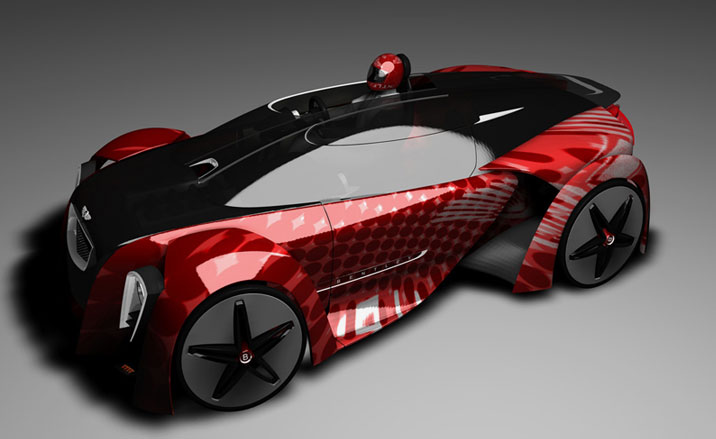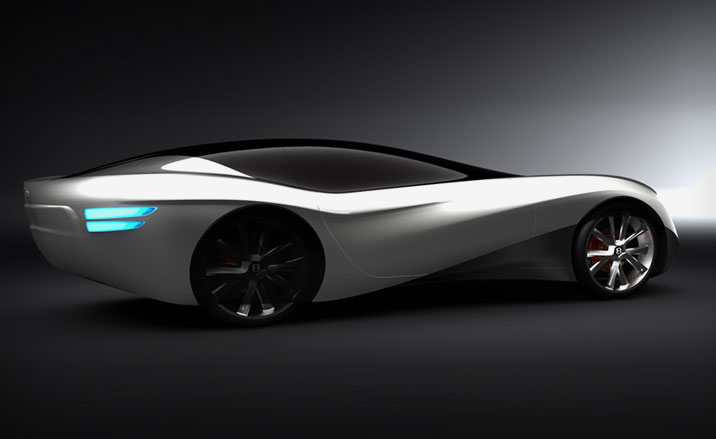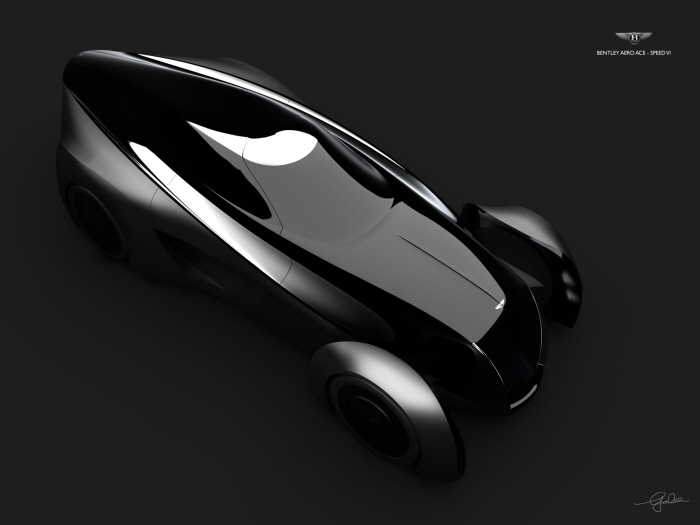
I noticed a story on a student design project for Bentley at the UK’s Royal College of Art called the Aero-Ace in the always fabulous Wallpaper magazine. Definitely worth sharing, and adding to as well. The text and images below are from their January, 2010 issue, plus I’ve added some video and additional images and sketches from the artists.
The challenge:
“Explore a new Aerodynamic lead design direction for Bentley, develop a digital design for a Bentley coupe that speaks to lean mid 21st century tastes, and that truly embraces aerodynamics to both reduce energy consumption and form part of a future Bentley design aesthetic.”
Bentley Aero-Ace project
Sam Livingstone, senior tutor in vehicle design at the Royal College of Art recently noted, ‘We are seeing a return to the prominence of aerodynamics, and the aerodynamic look, to both deliver and visually convey efficiency.”
This was the initiative behind Aero-Ace, a collaborative design project, just completed with Bentley – the objective being to explore a new aerodynamic design direction for the luxury marque. Second year RCA students were asked to identify a new vehicle direction for Bentley that would appeal to the ecologically conscious consumer.
Aided by specialist EXA evaluation software PowerFlow, their two-dimensional design proposals for a conceptual coupé needed to embrace aerodynamics in order to both reduce energy consumption and form part of a future Bentley design aesthetic.
The software simulates the aerodynamics of design at a digital model stage. The advantage being that it enables two-dimensional models to be accurately tested for their aerodynamic performance without having to make an actual real-life car.
The 11 participating students came up with very different proposals, with aero performance results ranging from CD 0.167 to 0.35. Livingstone notes: ‘There are no two that are thematically similar despite all being large Bentley coupés.’ The degree to which aerodynamics plays a role depends on the marque, although Livingston has noticed a growing trend in considering aero performance at the early stages of design.
Exacting customers now expect their cars to have unwavering stability in all conditions, offer refined driving and the sort of speeds that 20 or so years ago would have applied only to purist sports cars. ‘So aerodynamics in car design is unarguably more important than ever. However, some companies still consider aerodynamics only at the end of a programme where they merely tweak details,’ says Livingstone.
The winner will be announced on 4 February and will spend six months working at Bentley.
above: Shawn Deutchman, 26 from the US
Deutchman has proposed the Silhouette, an electric car that announces its power through a long bonnet and muscular rear stance. ‘Like a sprinter leaving the blocks, the vehicle has a forward momentum,’ he says.
above: Anand Krishnan, 29 from India
‘Bentley is associated with power and style, which I interpret as refined aggression,’ explains the designer. The second skin works as a layer to channel air away to the rear for improved aero performance.
above: Augustin Barbot, 26, from France
Barbot has created an aerodynamic sports car with very thin wheels, featuring four wind turbines integrated in the wheel arches to provide the batteries with electricity. The double curved roof minimises air resistance. ‘The two-part retractable roof allows the seats to move into three different configurations: the driving position of a speedster, a coupe and a roadster, all in one car,’ says the designer.
above: Dalibor Pantucek, 26, from the Czech Republic
The Spitfire was inspired by Bentley’s airplane engine-making heritage – the teardrop body shape taking direct cues from aviation. The hidden wheels work like aircraft wings helping with down force
above: David Seesing, 26 from Germany
The Mirage is a 2+2 seater electric concept car, aimed at a younger buyer. ‘With only two eyes, the Mirage shows its real identity when the blacked out headlights are switched on,’ says Seesing. ‘The vertical orientation of the lights takes inspiration from Bentley’s historic 8-litre car.’
above: Gabriel Tam, 27 from Australia
The Speed VI aims to revive and celebrate the sporting heritage of Bentley Motors. ‘Following in the footsteps of the original Speed 6, 4½ -litre, and more recently the Speed 8 Le Mans racer, the Speed VI is created for the discerning Bentley track day enthusiast,’ says Tam.
above: Jong Won Lee, 33 from South Korea
The N(Neo fire) has been inspired by the post-neoclassical period, says the designer who has covered the wheels for enhanced aerodynamic efficiency.
above: Miika Heikkinen, 26, from Finland
TEN11 is inspired by the number of feathers in the Bentley logo – 10 on the left, eleven on the right. Heikkinen designed the electric prototype with a professional kite boarder in mind. ‘The traditional long bonnet creates a possibility to have a big storage place under it – a feature demanded by a lot of Bentley customers,’ says the designer.
above: Niki Merriman, 24 from the UK
Insects were the inspiration behind Nodus, with its overlapping layers on the body panel. Merriman has covered the rear wheels to aid the aerodynamics. When stationary the side windows have the ability to change to the same colour as the body for security and privacy. When the vehicle is in use the colour bleeds away to a clear window.
above: Philipp Siebourg, 30 from Germany
‘My mid-engine vision is influenced by Bentley’s racing tradition,’ says Siebourg. The teardrop cabin guides airflow to the rear, the diffuser manages to reduce the lift of the vehicle in the back, plus the low bonnet cuts back on turbulence at the front of the vehicle.
above: Rui Guo, 22 from China
The Serenade GT is an electric sports car inspired by jewellery. The two channels between the hood and front wheels guide airflow through the body to the side, for reduced air drag. Guo explains: ‘The structure at the rear end naturally forms a two-layered diffuser, increasing the down-force from the airflow.’
Now, some additional images of the work not found in Wallpaper, courtesy of the artists:
Sketches of the Bentley Aero Ace project by designer Dalibor Pantucek who was inspired by Bentley’s airplane heritage:
Sketches from Round II of the Bentley Aero Ace Project by designer Miika Heikkinen:
Kketches of the Bentley Aero-Ace project by Augustin Barbot:
Additional designs for the project by Philipp Siebourg:
Additional designs for the project by Gabriel Tam:
And a video of 27 year old designer Gabriel Tam‘s Bentley Aero Ace – Speed IV Concept Car
Inspired by the original Speed 6 driven to victory by the Bentley Boys of the 20s’at Le Mans, the Speed IV concept is an overtly sporting vehicle with the raw aggression of a pure blood racer, whist retaining the refined elegance of past Bentleys. -Gabriel Tam:
Many of these same talented students were noted in Dezeen’s 2008 article on design concepts for the EuroK- Car























